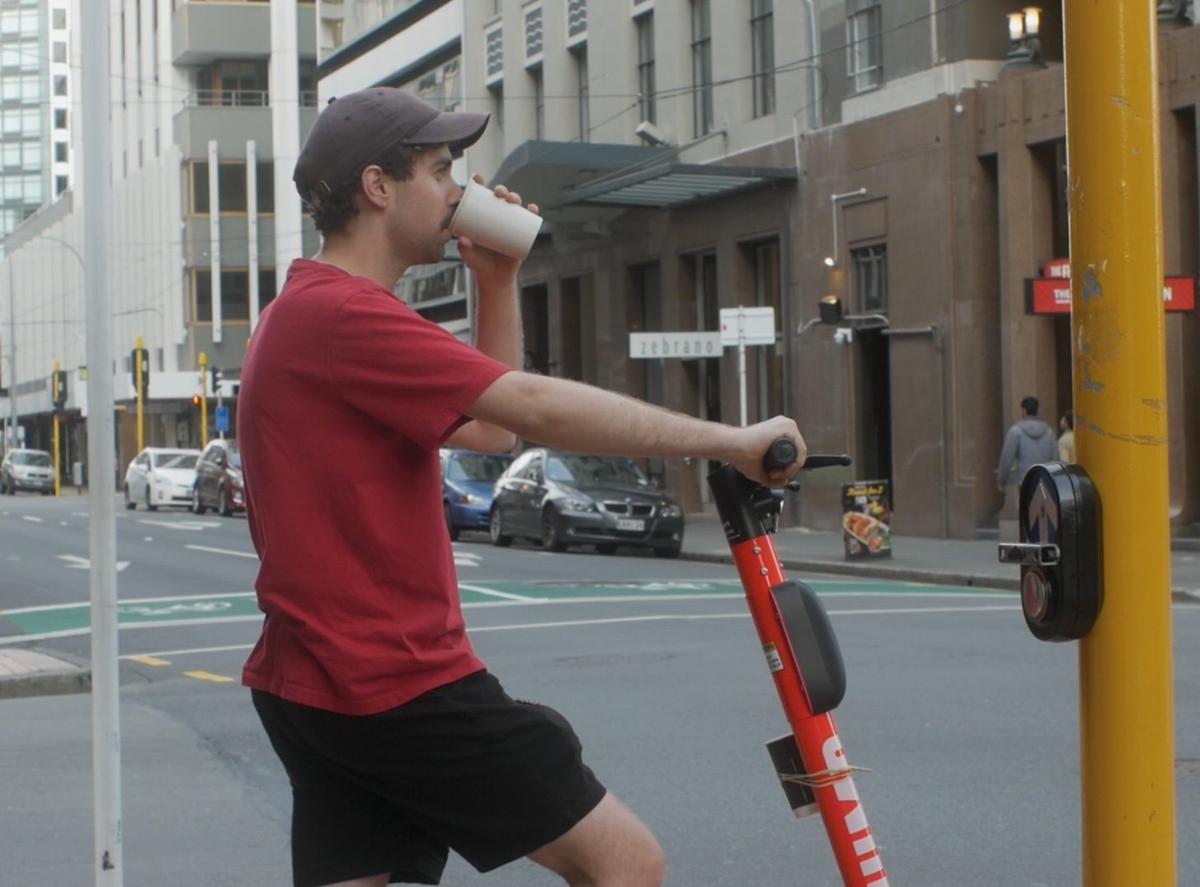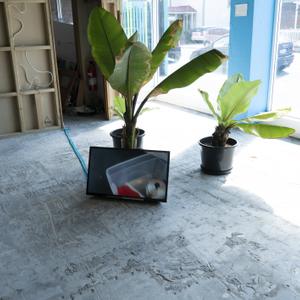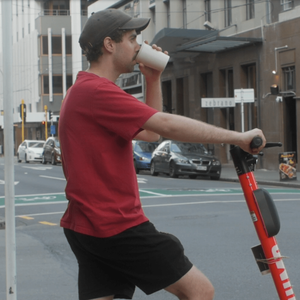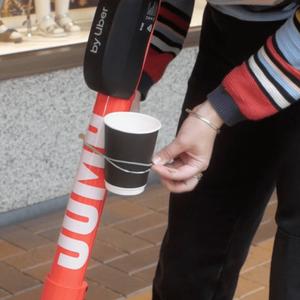Max Fleury is an artist based in Te Whanganui-a-Tara whose practice examines public space, the lifecycle of everyday objects, and clashing ideas of value. Working often with a collaborator, he creates wry, humorous performance works for camera. Here he discusses four works on CIRCUIT that include collaborations with Anna Brimer, Bena Jackson, and Sabina Rizos-Shaw.
Mark Williams (MW): The four works we're about to put on-site feature an e-bike, public sculpture, and a pop song. My reading of your work is that it's about the commons, but more specifically the point where some people's personal choice becomes someone else’s public nuisance. Does that seem like a reasonable starting point from which to read your practice?
Max Fleury (MF): That sums up the ideas at the widest level, I suppose. And taking an interest in aspects of public life that are available to me for free.
MW: Could you talk a little bit more about that?
MF: I don't really like buying materials. I started out going to art school, wanting to be a painter and then realising that you just end up with a whole lot of paintings you don’t really want to do anything with, no one wants, and they just get thrown in the tip. I tried to think about making works with what was lying around.
MW: That brings us to a work you made with Anna Brimer in 2020 called Glory which was commissioned by CIRCUIT as a work in response to the suburb of Newtown. How did you come to work with Anna on this project?
MF: Anna and I had spent a lot of time in op shops together. When I was trying to think of a work that would respond to the materials of Newtown and the op shops being a big part of that, she was the first person that came to my mind. Normally [we go there] to find clothes that we like, bits of furniture to decorate the house with, or books, or CDs that might be cheap and have some entertainment value. For Glory, we were attracted to slightly pathetic things. You would think, “Why would anyone have ever wanted that in the first place? That's really ugly. Or, that's really bad quality.” Maybe no one ever wanted it and it's just ended up there, and that's a little bit funny and a little bit sad.
MW: The video begins with a gathering of junk from Newtown opportunity shops, then there's the public performance using an outdoor tap. Could you talk about the development of the work?
MF: I was thinking about other artists that were in the AURA festival whose work I admire. There were the water fountains by Louisa Beatty that were shown in the old service station that's now a bike repair shop. So, the work was a response to the festival in that way. And I was thinking about Campbell Patterson taking soap from a public toilet and using that as material in his work [Soapstealer, 2004]. At the time I was making a lot of sculptures out of stuff that I bought from the op shops around Newtown. I guess it was just a combination of all of those interests into making one video.
MW: It's pretty funny that you realised being a painter meant you've got to somehow store and deal with all this stuff, but you pivoted towards gathering crap that people throw away.
MF: I liked that you could buy stuff from an op shop and then donate it back to an op shop afterwards. Although I did find some things they do not want, such as TV cabinets and shell pools. They'll sell them, but they won't buy them back. Well, take them back.
Max Fleury and Anna Brimer, Glory (2019). Commissioned by CIRCUIT for AURA Festival of Artist Moving Images (2019)
MW: Talking about this idea of the commons, you made Glory in very public spaces, by a playground and the Newtown library. We see local people in the background of the video watching you and Anna make these crazy assemblages. Then you do this bizarre performance of spraying them with water. Was that visibility of the locals in the video intentional or is it something that just came out through the edit?
MF: I wanted that to be a part of the work because it is a very public place. In my heart, I hoped there would be no one around because that would be much more straightforward and less embarrassing. But it was nice that there were lots of other people around. People talked to us quite a bit as well. And there were awkward things like someone soiled the toilet and council workers were coming in to clean it up while we were sellotaping stuff to the building.
MW: Let's talk about Same thing everyday (2020). In the video we see images of Wellington public art sculptures, interspersed with comments from the internet about public art. It encapsulates art's awkward relationship to the commons, as in “Who is this art for?”
MF: Yeah. I mean, that's what I was interested in: we see our surroundings, but we don't see what people think of them. And it's about working through how people engage with public works and express their opinions. It's probably a really confusing work to look at without the context of the show. Bena Jackson and I proposed to make a maquette of the perfect public sculpture and researched what that might be. It was a year-long project that ended up being a lot of conversations with people who work in public art, looking at the assessment processes for how that work is made and assessed on an institutional level. The video mixes in more pedestrian ways of looking at things, and includes people's immediate responses [sourced from internet comment boards].
MW: I guess it was pretty timely. At the time there was a lot of conversation about Shona Rapira Davies' work in Te Aro Park.
MF: Yeah. And lots of stuff in the media about colonial sculptures and whatnot, and people questioning the orthodoxy of what should be revered in a public space.
Same thing everyday (2020) Max Fleury & Bena Jackson
For Glory, we were attracted to slightly pathetic things. You would think, “Why would anyone have ever wanted that in the first place? That's really ugly. Or, that's really bad quality.” Maybe no one ever wanted it and it's just ended up there, and that's a little bit funny and a little bit sad.
MW: What do you think is a good public sculpture?
MF: Effectively or towards my shallow tastes?
MW: Either.
MF: I really just love, love [Ronnie Van Hout's] Quasi (2016). It's not super interesting because it is attached to an art gallery. But I like how that artwork had a lot of life in the media and it was discussed on the news and in Facebook comment sections. And it's a work about giving objects human qualities…it's figurative and slightly creepy, and I think that gets a lot of response from people. I guess a good public sculpture is one that's talked about, not one that fades into the background.
MW: In 2020 you presented a collaborative show with Sabina Rizos-Shaw at play_station gallery in Wellington called Slow Cover. Sabina filled the room with large sculptures, you presented a video of yourself performing the song Honey by the pop artist Robyn. What was the meeting point for this collaboration with Sabina?
MF: I talked with Sabina about how we could bring our practices together in a way that expanded on the ideas within our own work. I was trying to envision a character that would play with the ethos of a cover song.
MW: You were playing a character?
MF: I mean, the character was me, but I think the character was also a little bit of a problem. It's this guy that picks up a guitar and covers this pop song, by a campy female artist and makes it subdued and mournful. The original was probably more moving, but in a less affected way than the acoustic cover artist.
MW: And then it gets thrust back into the court of public opinion on YouTube.
MF: Yeah. It's quite visceral to watch videos of covers because people put so much out there—their taste and what they consider to be good or bad. I think it shows that in a really immediate way.
Max Fleury, Lazy Sunday (2020)
MW: Bena Jackson is a collaborator on more than one project. Why did you decide to work with Bena on the work about e-scooters, One who goes quickly (2020)?
MF: Bena was someone I worked with at art school. We had a lot of artists in common that we were interested in, and similar sensibilities. Outside of art school the first project that we ever proposed together was a real mess. We were proposing a remake of The DaVinci Code (2006) using an AB Circle Pro.
MW: What's an AB Circle Pro?!
MF: It's one of those infomercial workout machines where you would swing around and it would give you hot sexy abs if you do it for long enough. We wanted to frame it around the letters of Alice May Williams, who was a pseudo-scientific astrologer from New Zealand, who would send her letters to this observatory in the States. I think it was Los Angeles. She made some pretty out outlandish claims about the galaxy.
MW: Sounds…complicated!
MF: It wasn't really working. And it was rightfully rejected by a few places that we proposed it to. One who goes quickly we wrote together the week that e-scooters were released onto the streets of Wellington. And we were suddenly a lot more grounded. We thought about aspects of the city that would be changing. And there was this new technology that would probably be changing a lot quite quickly. [We thought] it would be nice to do a time capsule for it.
MW: It seems like you're going back to an idea that's in Glory, where you identified objects that are old and clearly past their usefulness, faddishness or whatever. But in One who goes quickly, maybe you’re casting that notion onto an object that is very contemporary.
MF: Yeah. And I thought e-scooters were interesting because so many people seem so irritated by them, as they often are by objects that are new.
MW: I love where you scoot through the forecourt of the petrol station, using the scooter to draw a chalk line. That seems such a classically formal art historical gesture with a current device.
MF: Yeah, [I wanted] to turn an unconventional thing into a drawing tool.
Max Fleury and Bena Jackson, One who goes quickly (2019). Commissioned by CIRCUIT and Wellington City Council
MW: What do you think Bena brought to that collaboration?
MF: Normally when I plan to work, it's in a very short period of time and the results edited down with some snappy editing. But I think working with Bena, she likes to spread projects out a lot more and make perhaps a more interesting web of footage then I would do myself.
MW: What guided the editing process?
MF: I think about rhythm when I'm editing videos together. Watching the action unfold and thinking about how it feels, if you cut it there, as opposed to cutting it there, and giving it flow and momentum. I obviously don't work in a way that uses long takes or seeing things unfold in real time. Maybe being bored is okay. But also I'm trying to be conscious of how the media captures your attention. I think about how it works on YouTube, Facebook, and Instagram, rather than the dominance of long takes that are often seen in artist moving image.
MW: Once again, there’s that gap between the public sphere and the contemporary art world.
MF: Yeah, for sure.



